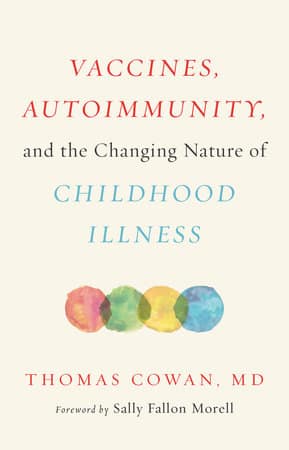What is Autoimmunity?

Autoimmunity, the body’s immune system fighting off its own healthy cells and tissue, is concerning to the say the least. Add to that the 80 plus autoimmune diseases that can occur as a result and we’ve reached high alert. So what’s causing these diseases and is there anything we can do to prevent them?
The following excerpt is from Vaccines, Autoimmunity, and the Changing Nature of Childhood Illness by Thomas Cowan, MD. It has been adapted for the web.
What Is Autoimmunity?
In conventional medicine, autoimmune diseases—which include such diverse conditions as rheumatoid arthritis, lupus, Hashimoto’s thyroiditis, eczema, asthma, Graves’ disease, pemphigus, and multiple sclerosis (MS)—are considered idiopathic, meaning that we don’t know the causes. That being said, even in conventional circles, there are some aspects of autoimmunity that are considered settled science: There is an “overstimulation” of the immune system such that it produces an excessive amount of antibodies. These antibodies, for reasons unknown, start to cross-react with one’s own tissues. This cross-reaction means your humoral (antibody-based) immune system recognizes your own tissues as “foreign” and directs a destructive, inflammatory response at them. It is as if the immune system “thinks” your thyroid (in Hashimoto’s or Graves’ disease), or myelin sheath (in MS), or lung tissue (in asthma) is an invading microorganism or foreign toxin and brings the force of its destructive powers to bear against this tissue to neutralize and eliminate it. This is an incredible “strategy” against an invading virus or environmental toxin. It is devastating when directed, for example, against the body’s own thyroid gland.
As the assault proceeds, symptoms related to inflammation or dysfunction of the targeted tissue manifest. For example, if the disease is rheumatoid arthritis, the targeted tissue is the cartilage in the joints. As the disease progresses, the patient experiences progressive inflammation, heat, redness, swelling, joint pain, and potential disability. If the inflammatory attack is directed against the myelin sheaths, eventually there will be poor nerve impulse transmission and dysfunction of the areas fed by these nerves. If the nerves to the bladder are involved, there will be urinary symptoms. If it’s the nerves to the legs, problems with the gait will emerge. In Hashimoto’s thyroiditis, the attack is against the thyroid gland, eventually resulting in the gland’s inability to produce thyroid hormones. Once this happens, all the classic symptoms of hypothyroidism will emerge.
This is the simple, conventional explanation for an autoimmune disease. The idiopathic part is that there is generally no explanation for why the humoral immune system creates an excessive amount of antibodies, nor why these antibodies cross-react and target our own tissues.
Back when I was in medical school, I noticed strange inconsistencies in the way autoimmune disease is conventionally treated. Consider, for example, two common autoimmune diseases: rheumatoid arthritis and Hashimoto’s thyroiditis. Both are antibody-mediated inflammatory attacks on the body’s own tissue.

With rheumatoid arthritis, conventional treatment gets a degree closer to proper treatment by trying to identify the underlying immune response, though its methodologies are still misguided. That is, a patient who is diagnosed with rheumatoid arthritis will generally be referred to a rheumatologist, an autoimmune specialist, rather than an orthopedic doctor who specializes in the treatment of bones and joints. The focus is not primarily on the patient’s joints. He is not given joint medicine, joint glue, or joint exercises, except perhaps to relieve the symptoms of joint pain, stiffness, and acute inflammation. He is prescribed medication to prevent his body from making anti- bodies. Unlike Hashimoto’s thyroiditis, in which the focus of treatment is on the targeted organ, in the treatment of rheumatoid arthritis, little attention is paid to the targeted organ, or, in this case, the joints, except perhaps in the short-term acute treatment of symptoms to relieve pain and discomfort.
I’ve never heard an explanation for this inconsistency. Why is one autoimmune disease—which is solidly recognized as an autoimmune disease—treated like an end-organ disease, while another autoimmune disease is treated as if it’s a disease of the immune system?
My guess is that it is a matter of practicality; certain approaches are practical or impractical depending on a given situation. If the immune system is destroying the thyroid, simply wait until the thyroid is more or less destroyed and then take synthetic hormones (or so conventional medicine says) to replace the thyroid’s function. If the immune system is destroying the joints, it isn’t possible to wait until the joints are destroyed and then replace them. We have to stop the immune system’s assault on the joints. What this inconsistency tells me, however, is that conventional medicine hasn’t advanced far enough to identify effective treatments that address the underlying immune response—which is at the root of both diseases.
Rheumatoid arthritis may be more squarely treated as an autoimmune disease, but of course the problem with using immune-suppressing medications to stop the assault on the joints—besides the many awful and often serious side effects of these drugs—is that suppressing the immune response doesn’t cure the underlying autoimmune disease any more than synthetic hormones cure the underlying autoimmune disease that launched the assault on the thyroid in Hashimoto’s thyroiditis in the first place. The immune response is not the cause of the disease. It is the “pus” trying to get the “splinter” out. The rational therapy for any autoimmune disease is to identify the “splinter” and somehow pull it out.
If there is an ongoing immune response, the crucial questions are what antigen(s) is causing the body’s excessive antibody response and how did the antigen end up in the bloodstream? Consider celiac disease, in which the sequence of events has been fairly well established: There is damage to the gut (and its microbiome), including to the microvilli, the hairlike cellular structures that protrude from the gut wall to absorb nutrients and prevent leakage. The gut wall becomes inflamed and, over time, muscular and mucosal layers deteriorate, leading to leaky gut. Large gluten molecules are then able to gain access to the bloodstream, where the body tries to neutralize them by making antibodies to identify and tag them for destruction. These antibodies may react with the body’s tissue, including the bones, brain, and joints, creating a myriad of both acute and chronic symptoms.
While it’s true that antibodies are damaging to our own tissues, they are not the source of the problem. The source of the problem is the leakage of unwelcome proteins into the bloodstream, resulting from damaged microvilli, which are caused by a compromised microbiome. There may be many reasons for a compromised microbiome, including exposure to a poorly tolerated substance—such as gluten.
Treating autoimmune disease, and specifically celiac disease, with pharmaceuticals is an ineffective approach to stopping the tissue destruction and decreasing antibody levels. The medications, which need to be given in huge quantities to have any impact, create a slew of other problems that can include lymphoma, pneumonia, cataracts, and diabetes. They also treat the response, not the cause, of the disease.
Once foods containing problematic ingredients (such as gluten, heated dairy protein, or soy) are eliminated from the diet, the microbiome can heal, the villi can be restored, gluten will stop showing up in the blood, and the body will stop producing antibodies. This strategy reliably breaks the cycle of celiac disease and it should be the model for the treatment of all autoimmune diseases.
There are other explanations for the presence of excessive antibodies in the bloodstream; antibody production is, after all, the goal of vaccination. We now know that stimulating an antibody response without prior cell-mediated activity does not produce the correct type of antibody response. It’s not as longlived and it has the risk of being under- or overactive.
What we are doing when we vaccinate—overstimulating immune response and provoking antibody formation—is what the body is doing in autoimmune disease. We are literally injecting antigens into human beings to stimulate immune response and antibody production and then wondering why so many people have constantly stimulated immune response and antibody production. There is a big difference between this happening naturally in the context of a cell-mediated response and provoking it intentionally while trying to sidestep the cell-mediated response.
It’s also worth noting that when the antibodies destroy (or tag for destruction) certain tissues, nuclear material (DNA predominantly) from the cells that make up the affected tissues spills into the bloodstream. This situation also stimulates the body to create antibodies to target the DNA and other nuclear and cellular material, which accentuates the antibody assault on the affected tissue—for example, the thyroid in Hashimoto’s thyroiditis. Thus, we see a vicious cycle of antibody-mediated tissue destruction, leading to increased cellular DNA in the bloodstream, leading to increased production of antibodies, leading to more tissue destruction, and so on. Autoimmune diseases are not usually self-healing due to this cycle. Something must be done to break the cycle.
Recent Articles
Easy rainbow coleslaw! Transform your salad game with this colorful recipe. It is surprisingly packed with flavor and is a great addition to your repertoire.
Read MoreLearning how to ask questions that will elicit relevant information is as much an art form as creating an herbal formula. Follow this broad list as a starting point.
Read MoreWant to start your own medicinal herb garden? Passionflower, lemon balm, and goldenseal are great places to begin! These herbs are jam-packed with medicinal properties and easy to grow in a majority of climates.
Read MoreSprouts are easy to cultivate, mature quickly and pack a nutritional punch! You can make nutrient-rich sprouts from all kinds of edible seeds in your kitchen.
Read More









